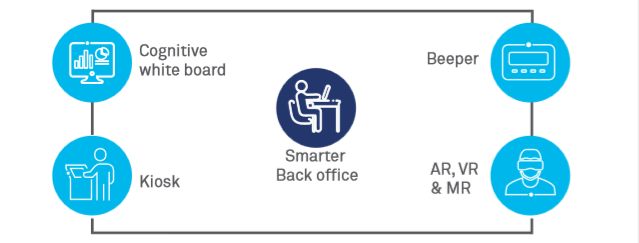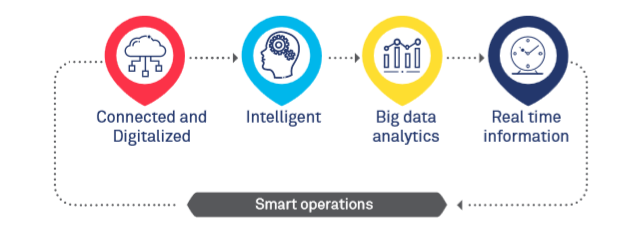Imagine sitting at your workstation and allowing a chatbot to start an intelligent conversation and handle client queries. Or, the whiteboard automatically taking notes while you dictate. What if you could change slides of a presentation or control the illumination with just a wave of your hand? Smart Operations (SO) promises all of that and more. It has the potential to make back-office operations intelligent and revolutionize the service industry in its wake. Harvard Business Review in “How Smart Connected Products Are Transforming Competition” claims smart connected products will bring in the Third IT Wave 1, which will see the integration of IT with SO, with sensors, processors, and advanced software as the backbone. No longer would Artificial Intelligence (AI) or Robotic Processes Automation (RPA), and Blockchain technology, merely hover in the horizon and stay restricted to theories and thoughts.
It will make operations lean and agile by automating the most manual of processes, allowing employees the bandwidth to handle complex workloads. This will effectively boost innovation and creativity. Greater collaboration with partners and clients with quality solutions will change industry standards after the tried and tested Lean and Six-Sigma methodologies. Service industries come with extreme volatility. That is why, organizations need to peel off their legacy mindsets and embrace this change while dedicating a significant amount of their resources towards its development. Organizations will gain a huge competitive advantage that will eventually provide them the opportunity to redefine industry standards.
How are things becoming “smart”?
Analysis of leading business sectors reveal that the transition towards “smart” began a while ago starting from electronic devices, which comes with integrated AI that can register voice commands and run errands virtually like a personal assistant. Cell phones have become “Smart Phones”, they come with self-healing features with sensors and actuators that can perform behavioral analysis of the user and even remotely control other devices.
Automobiles come with intelligence. A leading automobile maker employs situational awareness, which can predict and prevent accidents. Automatic service requests prevent potential failures. “Driverless Cars” no longer are a figment of our imagination. Healthcare sector in the 21st century promises innovative and
cost-effective ways of treatment through “smart healthcare solutions”. Patients can stay connected and share health reports. Medicine dispensers automatically upload data in the cloud. Doctors get intelligent suggestions based on big data analysis of historical cases. Palm-vein biometrics eliminates record duplication. Hospitals use e-ICUs and “Smart Beds” that can indicate occupancy or trigger alarms when patients attempt to get up. Robots can perform invasive heart surgeries. T-shirts come with integrated sensors that can track heart health.
A similar journey has started in the back-offices of the BPS industry. Cognitive whiteboards use intelligent office solutions. They can translate meetings into any possible language and ensure all meeting agendas are covered. They can even take notes and record conversations. Vibrators and beepers can help employees stay updated on important emails and messages enabling them to stay connected even in the absence of internet. Kiosks can assist employees to get real-time details on the status of their transactions. Any irregularities, which might have served as a bottleneck for other dependent processes, can be tracked immediately. Dynamic Workflows help prevent tools from getting obsolete. Processes do not depend on tools, rather, it is the other way around.
LCDs positioned strategically can flash critical messages and show updated information pertaining to a particular work-floor. Augmented Reality(AR)/Virtual Reality (VR) and Mixed Reality (MR) with virtual immersive training programs eliminate the need to relocate to training bases (See Figure 1).

Figure 1: Smarter back office

Figure 2: Smart operations
Intelligent
Organizations try and automate the most manual of processes when they attempt Business Process Re-engineering. SO uses automation beyond prevailing norms, which is called cognitive computing. This leverages RPA based on software robots or AI. Human-like reasoning and reviewing capabilities help to work in complete autonomy with bare minimum human intervention. Natural Language Processing (NLP) capabilities used in Chatbots enables them to strike intelligent conversations or handle queries.
Advantage:
Back office operations become increasingly productive, giving employees the bandwidth to handle complex workloads. Quality of work and resource utilization gets a significant boost.
Analytical Capabilities
SO uses big data analytics and machine learning also known as cognitive analytics. Machines gain the capability to “learn” on their own. Data gets collected through machine to machine interactions (M2M) and enriches the data reservoirs with any possible communication channel.
Advantage:
Analytics deployed in the right place can identify patterns in data and bring out meaningful interpretations. Descriptive, prescriptive and predictive analytics can help analyze customer behavior, estimate demands and prevent potential failures.
Real-Time data
Real-time data removes bottlenecks from every business process. As the name suggests, it captures events as it happens and there is no time lag in actual data reception.
Advantage:
It helps in getting live statuses on transactions, while helping in addressing irregularities faster.
Secure Data
“Smart Contracts” employing Blockchain technology has the potential to make finances and transactions more transparent. Decentralized databases are shared among permitted parties, which removes dependencies on intermediate parties. Changes can
be made only after mutual agreement of related parties.
Transparency in finances and revenues creates trust with stakeholders, with no scope for data manipulation. It saves time, and conflict. Removes third-party risk management programs from the value chain.
Connected and Digitized
The virtual data warehouse is a gold mine for any service organization. Strong analytics in place can bring forth meaningful insights. Connected devices serve as a gateway for seamless data exchange and is an enabler of greater interaction and collaboration.
Data points from every device could give unparalleled insights and provide immense scope for improvement in decisions and solutions.
What can “Smart Operations” do for an organization?
SO is the next logical step towards futuristic re-engineering aimed at reimagining back-office operations. It will bring in many benefits.The foundation of competitive advantage is based on operational effectiveness. SO will bring about the adoption of best practices across the value chain. This will make organizations lean and agile.There will be a substantial reduction in terms of waste and finances as a significant amount of rework due to quality issues is stemmed, and wait time due to other process dependencies are eliminated.SO will make an organization transparent in terms of finances or revenues for its stakeholders. Since “Smart Contracts” reduce the scope of manipulation, it will help build trust.Organizations will have richer R&D with automation of the most manual process giving employees significant bandwidth to devote time towards innovation and creativity.
What are the challenges while implementing “Smart Operations”?
Organizations will face myriad challenges while trying to implement smart operations in its business processes.
A significant part of the invested financial resources required to deploy updated software, advanced automation, analytics, tools and, suitable competency building training programs for employees can get wasted due to legacy work processes, mindsets and culture.
Employees with technological expertise are essential for successful SO execution. Organizations might be required to outsource technology-specific work to a third-party or undertake mergers and acquisitions to acquire the relevant capabilities or tools.
Consolidated databases are highly unstructured. Strong analytics is a mandate to identify patterns and insights. Stronger protection from cybersecurity and third-party management needs to be in place to prevent data from theft or leakage. Before proceeding to implement SO, organizations need a thorough understanding of its understated needs.
1.a. HBR_How-Smart-Connected-Products-Are-Transforming-Competition.pdf
b. https://www.wipro.com/business-process/robotics-and-analytics/
Rajesh Sehgal
Head - Quality, Process Excellence & Transitions, Digital Operations and Platforms, Wipro
Rajesh has over 23 years of experience in developing strategy for operational transformations across industry verticals, service lines and geographies. He is a certified Master Black Belt and has extensive experience in deployments of standards like Malcolm Baldridge, COPC, eSCM and EFQM.
Ram Kumar Chaudhary
Leader - Quality & Process excellence, Digital Operations and Platforms, Wipro
Ram has over 17 years of experience in conceptualizing and executing transformation themes in back office operations and shared services. At Wipro, he is responsible for driving transformation in Securities & Capital markets back office operations.